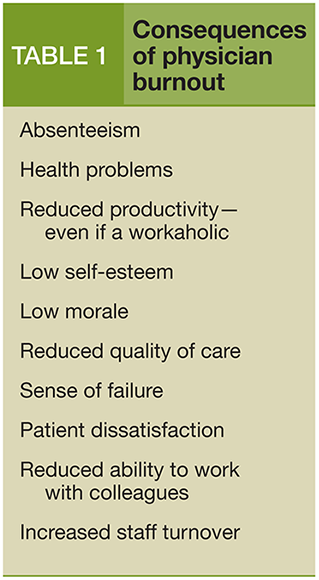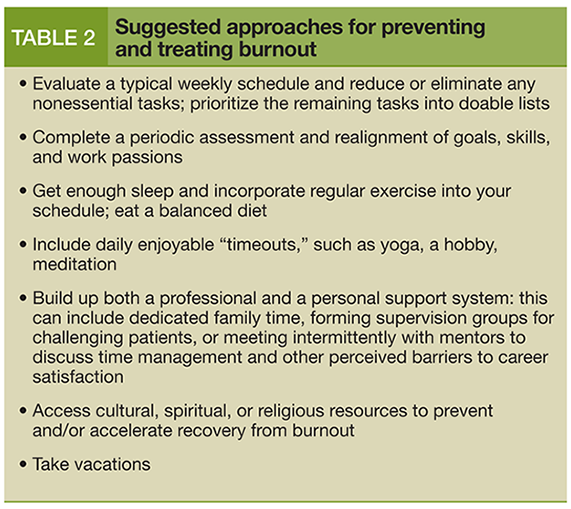Publication
Article
Psychiatric Times
“Burnout”: Strategies to Prevent and Overcome a Common-and Dangerous-Problem
Author(s):
Psychiatrists are particularly susceptible to burnout because of the nature of their work and the populations they serve. Combat strategies here.
Table 1: Consequences of physician burnout

Table 2: Suggested approaches for preventing and treating burnout

The pouches under his eyes were like purses that contained the smuggled memories of a disappointing life (career).
-Graham Greene,
A Burnt Out Case1
Burnout among physicians is common and preventable. There are many examples in literature of protagonists who have lost idealism and passion for their jobs and experienced fatigue and alienation-the hallmarks of burnout. Greene recounts the story of a disillusioned architect named Quer-ry who escapes his job by fleeing to Africa. Querry becomes “reconstituted” by working in a leper colony with patients called “burnt out” because they have ceased physical suffering at the price of becoming mutilated beyond self-recognition by the disease.
In the medical realm, “burnout” is a psychological term that became popular in the 1970s to describe chronic exhaustion and decreased interest in work. Particularly common in human services professions, it has been described as “a progressive loss of idealism, energy, and purpose.”2 The most widely used definition is one developed and quantified by Maslach and associates,3 which describes burnout as emotional exhaustion, depersonalization, and lack of personal accomplishment.
• Emotional exhaustion: tiredness, emotional depletion, fatigue
• Depersonalization: negative cynical attitudes, impersonal feelings, disengagement, isolation, impatience, frustration with patients or staff
• Lack of personal accomplishment: incompetence, ineffectiveness, inadequacy, sense of failure, apathy to protect against frustration, lack of perceived control
All 3 dimensions have been strongly associated with measures re-flecting emotional and physical strain, stress coping, and self-efficacy.4
Physicians can be particularly vulnerable to job stress, with high work demands and responsibility for the well-being of others, particularly distressed individuals and families. Psychiatrists are a particularly susceptible group because of the nature of their work and the populations they serve. Therapeutic work with highly distressed patients who may be traumatized, suicidal, homicidal, hostile, or unappreciative can leave clinicians feeling helpless, powerless, and depleted. This interactional process can be particularly problematic for psychiatrists who become isolated from peer supervision and/or mentorship contacts that help them process their feelings and actions.
Adverse or negative behaviors of a patient’s relatives also contribute to psychiatric job stress. External stressors, such as the changing health care environment, malpractice concerns, and job obligations divided between diverse systems and different obligations, also contribute to feelings of lack of professional accomplishment or “ . . . a gradual process of disillusionment in a quest to derive a sense of existential significance from work.”5 Collectively, these factors increase the risk of burnout.
Burnout affects up to 40% of psychiatry residents and up to 30% of practicing psychiatrists.6,7 The rates are lower for psychiatrists who work in inpatient settings.8 In subgroup analyses by career stage, middle-career physicians are most likely to be exhausted, while depersonalization and home-work conflicts were more common among early-career physicians.9 Late-career psychiatrists frequently retire early because of or to avoid burnout. Middle age is a challenging developmental time for many professionals-lost opportunities, acceptance of one’s limitations, and a loss of idealism can lead to disillusionment.
[[{"type":"media","view_mode":"media_crop","fid":"24264","attributes":{"alt":"burnout","class":"media-image media-image-right","id":"media_crop_4030529467644","media_crop_h":"0","media_crop_image_style":"-1","media_crop_instance":"2073","media_crop_rotate":"0","media_crop_scale_h":"176","media_crop_scale_w":"200","media_crop_w":"0","media_crop_x":"0","media_crop_y":"0","style":"float: right;","title":" ","typeof":"foaf:Image"}}]]The stages of burnout
The process of burnout occurs in 3 stages. Because prevention and treatment are possible, particularly in the earlier stages, it is important to recognize the stages.10
Stage 1 consists of milder signs and symptoms that are episodic, such as experiencing mental fatigue at the end of the workday; feeling unappreciated, frustrated, or tense; and having physical aches and pains. Often physicians feel that they are falling behind on goals and deadlines and are not meeting status quo requirements, and they experience growing dread at facing the next workday.
Stage 2 consists of longer-lasting symptoms that are more challenging to reverse, such as disillusionment about the job; pervasive feelings of boredom, apathy, or frustration; feelings of being ruled by a schedule; and intermittent periods of psychological or physical symptoms that persist even when the provoking situation subsides. Psychological symptoms include irritability, aggression, anxiety, depression, substance abuse (eg, caffeine, nicotine), and suicidal thoughts; physical symptoms include fatigue, sleep disturbance, changes in weight, and GI distress.
Stage 3 is severe burnout. The signs and symptoms have become more chronic and if left untreated can evolve into psychiatric and physical health disorders, such as depression, myocardial infarcts, and peptic ulcers. Often there are expensive personal consequences, such as divorce, high job turnover, substance dependence, shorter life expectancy, and completed suicide (Table 1).
Understanding burnout
Burnout is not a disorder. However, if it is unrecognized, burnout can become chronic. Burnout is more than just job dissatisfaction and more than just physical fatigue from which one can recover more quickly. It is not synonymous with job stress, since some individuals thrive under stressful conditions; however, if the stress becomes overwhelming or leads to maladaptive coping, the risk for burnout increases.
The early phase of burnout may have a protective effect on human psyche against further damage-ie, it can serve as a brake or warning signal.11 No clear biological markers have been found for early burnout, but with more chronic severe burnout, hypothalamic-pituitary-adrenal axis dysfunction (eg, “adrenal fatigue,” hypocortisolemia) has been implicated.12 Genetic or epigenetic factors have not been shown to promote risk or resilience, but they likely play a role.
Different schemas have been identified to help evaluate risk and preventive factors for burnout. Kumar and colleagues13 have identified 4 domains of burnout: predisposing, precipitating, perpetuating, and protective.
• Predisposing factors include traits such as a tendency to internalize stressful experiences, feelings of guilt, helplessness, and fatigue; workplace characteristics such as high demand, long hours, lack of workplace support, and lack of work-family balance; and stressful personal life events that can have a synergistic negative effect
• Precipitating factors include a patient’s suicide or homicide; a myriad of other challenges can also stress the clinician’s emotional resources
• Perpetuating factors are related to the psychiatrist’s perception of and response to stressful situations, appraisal style, changes in health services delivery
• Protective factors include a good professional–personal life balance; work activities that are related to a sense of professional accomplishment; a good system of support from colleagues, peers, and family; being physically active and taking vacations
Another model of burnout is transactional: the relationship between demands and available resources to handle them.14,15 Demands can be external (eg, environment, relationships, community) or internal (eg, self-concept, lifestyle, developmental stage). If there is an imbalance between demands and resources, tension, anxiety, fatigue, and exhaustion are common. As individuals attempt to cope, appropriate resources can improve coping attitudes and behaviors, restoring equilibrium and avoiding burnout. If these attempts are unsuccessful or maladaptive coping develops, severe burnout can occur.
Strategies to prevent or treat burnout
Early recognition of the burnout process and related risk factors is the most critical first step so that appropriate internal and external resources can be mobilized. Often there is self-denial of burnout, and physicians will try to cope with demands by working harder and longer, which can become a vicious circle to nowhere. Cultivating an ability to self-reflect, pausing to attend to one’s needs, and realigning goals and expectations are important internal processes, often easier to achieve with the help of trusted friends or colleagues. Exhaustion is often easier to treat than depersonalization and a sense of ineffectiveness. Table 2 presents suggested approaches for preventing and treating burnout.
Professional organizations can help identify and treat burnout among their clinician members. They can help establish clearly defined role and job characteristics, help build interpersonal relationships, and improve work environment and morale. Unfortunately, during this time of reorganization of the medical delivery system and budget constraints, many medical institutions and organizations have stopped funding social professional gatherings. During this period of existential stress for many health care professionals, these types of gatherings are especially important to help clinicians feel engaged, appreciated, and connected. Positive motivating factors, such as appreciation of job well done, promotions, and salary enhancement, can also go a long way in protecting against burnout.
Opportunities to process frustrations and barriers to career success are also critical to address burnout. Educational programs aimed at educating physicians about burnout and providing access to resources to teach more adaptive coping mechanisms are critical in all health care settings. If severe burnout is identified, appropriate treatment referrals to trained professionals can help with overwhelming stress, extreme negative cognitions, and/or resulting health problems. Some institutions have stress management programs or employee assistance programs available to professional staff. With screening and intervention in place, physicians can be most effective in avoiding burnout by maintaining a healthy balance between life and work while offering optimal clinical care.
Engagement is the goal of all burnout intervention strategies. It is the opposite of burnout and is a source of energy, involvement, and a sense of effectiveness. Greene’s Querry found fulfillment in helping others deal with adversity and suffering. These moments of healing and hope counter disillusionment and fatigue and help us celebrate our contributions to humanity.
Disclosures:
Dr Szigethy is Associate Professor of Psychiatry, Pediatrics, and Medicine and Director, Visceral Inflammation and Pain Center in the division of adult gastroenterology at the University of Pittsburgh; and Director at the Medical Coping Clinic at the Children’s Hospital of Pittsburgh. She reports no conflicts of interest concerning the subject matter of this article.
References:
1. Greene G. A Burnt-Out Case. New York: Penguin; 1960.
2. Edelwich J, Brodsky A. Burn-Out: Stages of Disillusionment in the Helping Professions. New York: Human Sciences Press; 1980.
3. Maslach C, Jackson SE, Leiter MP, et al. Maslach Burnout Inventory. 3rd ed. Palo Alto, CA: Consulting Psychologists Press; 1996.
4. Lee RT, Ashforth BE. On the meaning of Maslach’s three dimensions of burnout. J Appl Psychol. 1990; 75:743-747.
5. Maslach C, Schaufeli WB, Leiter MP. Job burnout. Annu Rev Psychol. 2001;52:397-422.
6. Martini S, Arfken CL, Churchill A, Balon R. Burnout comparison among residents in different medical specialties. Acad Psychiatry. 2004;28:240-242.
7. Medscape Physician Lifestyle Report, 2013. http://www.medscape.com/sites/public/lifestyle/ 2013. Accessed March 26, 2014.
8. Prosser D, Johnson S, Kuipers E, et al. Mental health, “burnout” and job satisfaction among hospital and community-based mental health staff. Br J Psychiatry. 1996;169:334-337.
9. Dyrbye LN, Varkey P, Boone SL, et al. Physician satisfaction and burnout at different career stages. Mayo Clin Proceed. 2013;88:1358-1367.
10. Simendinger EA, Moore TF. Organizational Burnout in Health Care Facilities: Strategies for Prevention and Change. Rockville, MD: Aspen Syst Co; 1985.
11. Kumar S. Burnout in psychiatrists. World Psychiatry. 2007;6:186-189.
12. Marchand A, Juster RP, Durand P, Lupien SJ. Burnout symptom sub-types and cortisol profiles: what’s burning most? Psychoneuroendocrinology. 2014;40:27-36.
13. Kumar S, Hatcher S, Huggard P. Burnout in psychiatrists: an etiological model. Int J Psychiatry Med. 2005;35:405-416.
14. Cherniss C. Staff Burnout: Job Stress in the Human Services. Beverly Hills, CA: Sage Publications; 1980.
15. Fawzy FI, Fawzy NW, Pasnau RO. Burnout in health professions. In: Lipsid JB, ed. Handbook on General Hospital Psychiatry. New York: Elsevier Science Pub; 1991:119-130.





